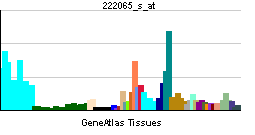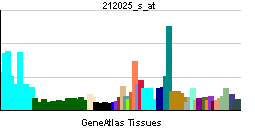FLII
| Flightless I homolog (Drosophila) | |||||||||||
|---|---|---|---|---|---|---|---|---|---|---|---|
| Identifiers | |||||||||||
| Symbols | FLII ; FLI; FLIL; Fli1; MGC39265 | ||||||||||
| External IDs | Template:OMIM5 Template:MGI HomoloGene: 11092 | ||||||||||
| |||||||||||
| RNA expression pattern | |||||||||||
 | |||||||||||
 | |||||||||||
 | |||||||||||
| More reference expression data | |||||||||||
| Orthologs | |||||||||||
| Template:GNF Ortholog box | |||||||||||
| Species | Human | Mouse | |||||||||
| Entrez | n/a | n/a | |||||||||
| Ensembl | n/a | n/a | |||||||||
| UniProt | n/a | n/a | |||||||||
| RefSeq (mRNA) | n/a | n/a | |||||||||
| RefSeq (protein) | n/a | n/a | |||||||||
| Location (UCSC) | n/a | n/a | |||||||||
| PubMed search | n/a | n/a | |||||||||
Flightless I homolog (Drosophila), also known as FLII, is a human gene.[1]
This gene encodes a protein with a gelsolin-like actin binding domain and an N-terminal leucine-rich repeat-protein protein interaction domain. The protein is similar to a Drosophila protein involved in early embryogenesis and the structural organization of indirect flight muscle. The gene is located within the Smith-Magenis syndrome region on chromosome 17.[1]
References
Further reading
- Chen KS, Gunaratne PH, Hoheisel JD; et al. (1995). "The human homologue of the Drosophila melanogaster flightless-I gene (flil) maps within the Smith-Magenis microdeletion critical region in 17p11.2". Am. J. Hum. Genet. 56 (1): 175–82. PMID 7825574.
- Campbell HD, Schimansky T, Claudianos C; et al. (1994). "The Drosophila melanogaster flightless-I gene involved in gastrulation and muscle degeneration encodes gelsolin-like and leucine-rich repeat domains and is conserved in Caenorhabditis elegans and humans". Proc. Natl. Acad. Sci. U.S.A. 90 (23): 11386–90. PMID 8248259.
- Campbell HD, Fountain S, Young IG; et al. (1997). "Genomic structure, evolution, and expression of human FLII, a gelsolin and leucine-rich-repeat family member: overlap with LLGL". Genomics. 42 (1): 46–54. doi:10.1006/geno.1997.4709. PMID 9177775.
- Liu YT, Yin HL (1998). "Identification of the binding partners for flightless I, A novel protein bridging the leucine-rich repeat and the gelsolin superfamilies". J. Biol. Chem. 273 (14): 7920–7. PMID 9525888.
- Wilson SA, Brown EC, Kingsman AJ, Kingsman SM (1998). "TRIP: a novel double stranded RNA binding protein which interacts with the leucine rich repeat of flightless I.". Nucleic Acids Res. 26 (15): 3460–7. PMID 9671805.
- Fong KS, de Couet HG (1999). "Novel proteins interacting with the leucine-rich repeat domain of human flightless-I identified by the yeast two-hybrid system". Genomics. 58 (2): 146–57. doi:10.1006/geno.1999.5817. PMID 10366446.
- Davy DA, Campbell HD, Fountain S; et al. (2001). "The flightless I protein colocalizes with actin- and microtubule-based structures in motile Swiss 3T3 fibroblasts: evidence for the involvement of PI 3-kinase and Ras-related small GTPases". J. Cell. Sci. 114 (Pt 3): 549–62. PMID 11171324.
- Campbell HD, Fountain S, McLennan IS; et al. (2002). "Fliih, a gelsolin-related cytoskeletal regulator essential for early mammalian embryonic development". Mol. Cell. Biol. 22 (10): 3518–26. PMID 11971982.
- Bi W, Yan J, Stankiewicz P; et al. (2002). "Genes in a refined Smith-Magenis syndrome critical deletion interval on chromosome 17p11.2 and the syntenic region of the mouse". Genome Res. 12 (5): 713–28. doi:10.1101/gr.73702. PMID 11997338.
- Strausberg RL, Feingold EA, Grouse LH; et al. (2003). "Generation and initial analysis of more than 15,000 full-length human and mouse cDNA sequences". Proc. Natl. Acad. Sci. U.S.A. 99 (26): 16899–903. doi:10.1073/pnas.242603899. PMID 12477932.
- Gevaert K, Goethals M, Martens L; et al. (2004). "Exploring proteomes and analyzing protein processing by mass spectrometric identification of sorted N-terminal peptides". Nat. Biotechnol. 21 (5): 566–9. doi:10.1038/nbt810. PMID 12665801.
- Lee YH, Campbell HD, Stallcup MR (2004). "Developmentally essential protein flightless I is a nuclear receptor coactivator with actin binding activity". Mol. Cell. Biol. 24 (5): 2103–17. PMID 14966289.
- Beausoleil SA, Jedrychowski M, Schwartz D; et al. (2004). "Large-scale characterization of HeLa cell nuclear phosphoproteins". Proc. Natl. Acad. Sci. U.S.A. 101 (33): 12130–5. doi:10.1073/pnas.0404720101. PMID 15302935.
- Gerhard DS, Wagner L, Feingold EA; et al. (2004). "The status, quality, and expansion of the NIH full-length cDNA project: the Mammalian Gene Collection (MGC)". Genome Res. 14 (10B): 2121–7. doi:10.1101/gr.2596504. PMID 15489334.
- Wang T, Chuang TH, Ronni T; et al. (2006). "Flightless I homolog negatively modulates the TLR pathway". J. Immunol. 176 (3): 1355–62. PMID 16424162.
- Beausoleil SA, Villén J, Gerber SA; et al. (2006). "A probability-based approach for high-throughput protein phosphorylation analysis and site localization". Nat. Biotechnol. 24 (10): 1285–92. doi:10.1038/nbt1240. PMID 16964243.
- Olsen JV, Blagoev B, Gnad F; et al. (2006). "Global, in vivo, and site-specific phosphorylation dynamics in signaling networks". Cell. 127 (3): 635–48. doi:10.1016/j.cell.2006.09.026. PMID 17081983.
- Kinsey M, Smith R, Lessnick SL (2007). "NR0B1 is required for the oncogenic phenotype mediated by EWS/FLI in Ewing's sarcoma". Mol. Cancer Res. 4 (11): 851–9. doi:10.1158/1541-7786.MCR-06-0090. PMID 17114343.
| This protein-related article is a stub. You can help Wikipedia by expanding it. |